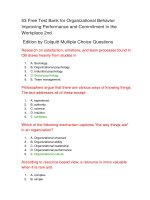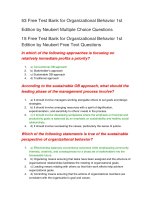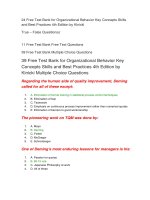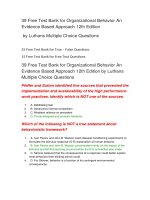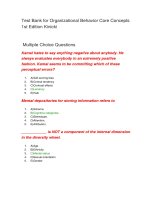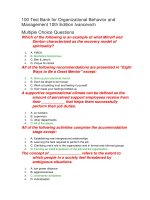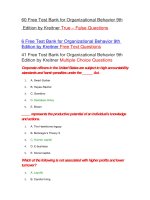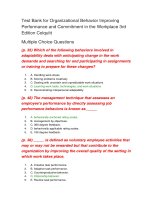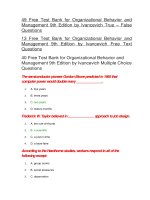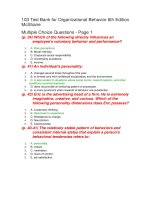102 test bank for organizational behavior and management 9th edition
Bạn đang xem bản rút gọn của tài liệu. Xem và tải ngay bản đầy đủ của tài liệu tại đây (119.19 KB, 22 trang )
49 Free Test Bank for Organizational Behavior and
Management 9th Edition by Ivancevich True – False
Questions
13 Free Test Bank for Organizational Behavior and
Management 9th Edition by Ivancevich Free Text
Questions
40 Free Test Bank for Organizational Behavior and
Management 9th Edition by Ivancevich Multiple Choice
Questions
The semiconductor pioneer Gordon Moore predicted in 1965 that
computer power would double every _______________.
1.
A. five years
2.
B. three years
3.
C. two years
4.
D. twelve months
Frederick W. Taylor believed in _______________ approach to job design.
1.
A. the rule-of-thumb
2.
B. a scientific
3.
C. a just-in-time
4.
D. a laize-faire
According to the Hawthorne studies, workers respond to all of the
following except:
1.
A. group norms
2.
B. social pressures
3.
C. observation
4.
D. discipline
According to the text, six forces are reshaping the nature of managing
within organizations. They include a new worker/employer psychological
contract, human resource power, globalism, cultural diversity, rapidity of
change, and _______________.
1.
A. the economic climate
2.
B. political unrest
3.
C. mentoring
4.
D. technology
The first modern management articles were published in _______________
journals.
1.
A. human resource
2.
B. engineering
3.
C. scientific
4.
D. psychology
Fayol's approach to management was significant, in that it contributed to
all of the following developments and positions except:
1.
A. Management is a separate body of knowledge that can be applied in any type
of organization
2.
B. A theory of management can be learned and taught
3.
C. There is a need for teaching management in colleges
4.
D. On-the-job training is the best way to impart management skills
Fayol's theory of management emphasized the importance of all of the
following except:
1.
A. Conserving
2.
B. Planning
3.
C. Organizing
4.
D. Coordinating
5.
E. Controlling
According to systems theory, an organization acquires resources (inputs)
from a larger system, which is _______________.
1.
A. the environment
2.
B. the home country
3.
C. the world economic system
4.
D. constantly changing
How well a firm _______________ and motivates a skilled workforce will
have a major impact on its ability to compete in the global marketplace.
1.
A. recruits
2.
B. retains
3.
C. selects
4.
D. All of the choices are correct.
Behavior is viewed as operating at individual, _______________, and
organizational levels.
1.
A. emotional
2.
B. spiritual
3.
C. structural
4.
D. group
The power of managers is clearly evidenced when they make decisions
about _______________.
1.
A. the employees' well-being
2.
B. distributing organizational resources
3.
C. designing and implementing rules and policies
4.
D. All of the choices are correct.
When it comes to knowledge, organizations must do all of the following
except:
1.
A. Transfer it to employees
2.
B. Identify it
3.
C. Guard it jealousy
4.
D. Update it continuously
In the agricultural era, _______________ was/were the core factor(s) in
achieving competitive advantage.
1.
A. improved crops
2.
B. having a local market
3.
C. land
4.
D. cheap labor
In 1886, an engineer named Frederick W. Taylor presented a paper on
scientific management at a national meeting of engineers that was titled
The Engineer as _______________.
1.
A. a Specialist
2.
B. a Manager
3.
C. an Economist
4.
D. a Scientist
Which of the following statements about power is true?
1.
A. Most people are comfortable with the concept of having power over others.
2.
B. The concept of having power over others is offensive to everybody.
3.
C. To be a good manager, a person must have a high desire for power.
4.
D. Managers derive power from both organizational and individual sources.
Adam Smith wrote in the Wealth of Nations, over two centuries ago, that
operational efficiency could be achieved most easily through
_______________.
1.
A. highly qualified employees
2.
B. high degrees of specialization
3.
C. a low employee-to-manager ratio
4.
D. equipment modernization
The foundation of organization performance is _______________
performance.
1.
A. product
2.
B. managerial
3.
C. financial
4.
D. individual
Which of the following statements about motivation is true?
1.
A. Motivation is the primary determinant of performance
2.
B. Most managers do not need to understand motivation
3.
C. Motivation and the ability to work interact to determine performance
4.
D. Most behavioral scientists agree that there is one best theory of motivation
Competition has caused many organizations to make quality their top
priority in the __________ run.
1.
A. short
2.
B. intermediate
3.
C. long
4.
D. All of the choices are correct.
According to the text, organizational survival is related to the ability of
management to do all of the following with information except:
1.
A. Consolidate it
2.
B. Transmit it
3.
C. Act on it
4.
D. Receive it
According to the National Academies' Center for Education, the U.S.
economy will continue to develop into a _______________ economy, with
high-paid, high-skill jobs at one end and low-paid, low-skill jobs at the
other.
1.
A. pyramid
2.
B. yo-yo
3.
C. barbell
4.
D. linear
The overarching criterion that cuts across the time dimension model of
effectiveness is _______________.
1.
A. productivity
2.
B. quality
3.
C. adaptiveness
4.
D. efficiency
Every organization must respond to the needs of _______________.
1.
A. its customers or clients
2.
B. legal and political constraints
3.
C. economic and technological changes
4.
D. All of the choices are correct.
Which of the following has contributed to the study of organizational
behavior?
1.
A. Psychology and sociology
2.
B. Social psychology and anthropology
3.
C. Political science
4.
D. All of the choices are correct.
Global competition is characterized by _______________ that bring
together countries, institutions, and people.
1.
A. networks
2.
B. laws
3.
C. regulations
4.
D. organizations
The introduction of _______________ fostered an era of "information
technology."
1.
A. electricity
2.
B. globalization
3.
C. computer technology
4.
D. the Internet
_______________ is the ability to get someone to do something you want
done, or to make things happen the way you want them to happen.
1.
A. Prestige
2.
B. Perseverance
3.
C. Power
4.
D. Persuasion
The competitive forces facing managers are led primarily by
_______________ changes and increasing globalization.
1.
A. technological
2.
B. environmental
3.
C. political
4.
D. economic
The Levi Strauss company emphasized all of the following throughout its
history, except:
1.
A. quick adaptation to current fashion trends
2.
B. quality
3.
C. being socially responsible
4.
D. hiring the most talented people
The success of an organization is determined by the way people work,
think, and behave. This is an example of the power of:
1.
A. Cultural diversity
2.
B. Globalism
3.
C. Human resources
4.
D. Psychological contracts
Frederick Taylor used _______________ studies to find the "one best way"
to do an effective (efficient) job.
1.
A. cause and effect
2.
B. time and motion
3.
C. return on investment
4.
D. repetitive action
_______________ is the ratio of outputs to inputs.
1.
A. Productivity
2.
B. Efficiency
3.
C. Adaptability
4.
D. Production
Which of the following countries is ranked highest on the Globalization
Index?
1.
A. United States
2.
B. Singapore
3.
C. United Kingdom
4.
D. Norway
As presented in the text, _______________ reflects the relationship
between inputs and output.
1.
A. productivity
2.
B. quality
3.
C. adaptiveness
4.
D. innovation
The neighborhood book club, which has fifty members, is an example of
a(n) _______________ group.
1.
A. informal
2.
B. formal
J. M. Juran and W. Edwards Deming, in 1950, introduced the importance
of _______________ to the public.
1.
A. quality
2.
B. efficiency
3.
C. profitability
4.
D. consistent management
The _______________ criterion measures the ability of an organization to
increase its ability to deal with environmental demands.
1.
A. productivity
2.
B. efficiency
3.
C. adaptiveness
4.
D. development
The Hawthorn studies originally concluded that supportive managers
paying attention to workers made them more productive. However, a
reanalysis of the data suggested that the productivity increase was due to
managerial discipline and _______________.
1.
A. fear of job loss
2.
B. peer pressure
3.
C. productivity bonuses
4.
D. job training
A surgical team performing open-heart surgery on a patient is an example
of a(n) _______________ group.
1.
A. informal
2.
B. formal
To develop and sustain an advantage in an increasingly competitive,
globalized world, managers must harness the powers of information
technology and _______________ to be successful.
1.
A. decisiveness
2.
B. language fluency
3.
C. democracy
4.
D. human capital
49 Free Test Bank for Organizational Behavior and
Management 9th Edition by Ivancevich True - False
Questions
Mary Parker Follett, following in the footsteps of Taylor's scientific
management, embraced his view of human needs and workplace
relationships.
1.
True
2.
False
In a general sense, technology is the process that converts raw materials
or intellectual capital into products or services.
1.
True
2.
False
Organizations tend to create societies, within which they may compatibly
exist.
1.
True
2.
False
The quality of decision making in an organization depends on selecting
proper goals, and then identifying the means for achieving them.
1.
True
2.
False
Quality is defined as meeting customer's needs and expectations.
1.
True
2.
False
To work effectively in organizations, managers must have a clear
understanding of the organizational structure.
1.
True
2.
False
The Hawthorne Studies discovered that workers are more productive
when they are observed and studied, because it makes them feel
important.
1.
True
2.
False
Frederick Taylor, father of scientific management, stated that there should
be an almost equal division of work and responsibility between managers
and non-managers.
1.
True
2.
False
An organization forms, develops, matures, and declines in relation to
internal political circumstances.
1.
True
2.
False
Leaders are exclusively managers within formal organizations.
1.
True
2.
False
The economic data churned out by the government every month fails to
identify whether workers are working harder or smarter.
1.
True
2.
False
According to the text, motivation and intelligence interact to determine
performance.
1.
True
2.
False
Technology can yield a competitive advantage only when it is utilized
effectively.
1.
True
2.
False
Stress can result from an imbalance in the interaction between the job and
the worker.
1.
True
2.
False
Systems theory is used to integrate organizational effectiveness and time.
1.
True
2.
False
The formal and modern study of management started in Babylonia,
around 5000 B.C.
1.
True
2.
False
World trade is growing at a slower rate than is world gross domestic
product.
1.
True
2.
False
Having control over others is an uncomfortable or offensive thought to
many Americans.
1.
True
2.
False
One of the basic concepts of systems theory is that managers must deal
with the internal aspects of organizational behavior before dealing with
the external aspects.
1.
True
2.
False
Information is a commodity that, when applied effectively, can result in
higher growth and productivity.
1.
True
2.
False
Jim, Mike, Kathy, and La Keisha are all friends at work because of their
common interest in raising chickens. Thus, they constitute an informal
group.
1.
True
2.
False
One of the least powerful influences on individual performance is an
organization's reward system.
1.
True
2.
False
With the passage of time, every organization takes, processes, and
returns resources to the environment.
1.
True
2.
False
Unlike products, organizations do not have life cycles.
1.
True
2.
False
According to Frederick W. Taylor, father of scientific management,
management and labor must operate independently to achieve the
maximum good for society.
1.
True
2.
False
Sometimes, performance of the work or job itself is all the reward an
employee needs.
1.
True
2.
False
The field of Organizational Behavior (OB) is personality-oriented.
1.
True
2.
False
The field of organizational behavior focuses on just two levels of analysis:
individual and group.
1.
True
2.
False
A common body of management knowledge had been developed prior to
the rise of the Roman Empire.
1.
True
2.
False
Mary Parker Follet was one of the first management theorists to promote
participatory decision making and decentralization.
1.
True
2.
False
During the Hawthorne studies, Harvard researchers found that individual
behavior was modified within, and by, work groups.
1.
True
2.
False
Leaders may be found in both formal and informal groups.
1.
True
2.
False
The Internet is an example of an electronic information sharing system.
1.
True
2.
False
Having conflict among groups is never good for an organization.
1.
True
2.
False
In certain situations, organizational effectiveness can be improved by
making significant changes in the total organization.
1.
True
2.
False
Most things that a leader will face within an organization are fixed and
inactive.
1.
True
2.
False
Change and innovation typically disrupt normal routines and patterns of
behavior.
1.
True
2.
False
A culturally diverse workforce is becoming a reality in the United States.
1.
True
2.
False
Efficiency is the extent to which an organization can and does respond to
internal and external changes.
1.
True
2.
False
Organizational survival is related to the ability of management to receive,
transmit, and transform information.
1.
True
2.
False
A new industrial era began in the United States around the time of the
Civil War.
1.
True
2.
False
Interpersonal influence and group behavior are powerful forces that can
influence organizational behavior.
1.
True
2.
False
In the field of Organizational Behavior (OB), the scientific method is
deemed important in studying variables and relationships.
1.
True
2.
False
In recent years, Japan and China have become racially diverse societies.
1.
True
2.
False
African-Americans are one of the slowest-growing groups in the U.S.
employee workforce.
1.
True
2.
False
Whether stress is positive or negative depends on an individual's
educational background, gender, and age.
1.
True
2.
False
Organizational Behavior (OB) is considered a way of thinking.
1.
True
2.
False
People behave in both predictable and unpredictable ways.
1.
True
2.
False
In the past several years, the percentage of managers and professionals
working 49 hours or more per week has increased.
1.
True
2.
False
13 Free Test Bank for Organizational Behavior and
Management 9th Edition by Ivancevich Free Text
Questions
The power of human resources, globalism, cultural diversity, the rapidity
of change, a new worker-employer psychological contract, and
technology are reshaping management practices. What are the likely
outcomes of ignoring or resisting these forces?
Answer Given
Resisting these forces will likely lead to unnecessary conflict, reduced managerial
and non-managerial performance, and lost opportunities. In managerial terms, it
can also lead to job dissatisfaction, poor morale, reduced commitment, lower work
quality, burnout, poor judgment, and other unhealthy consequences.
As a manager, what type of quality improvement results should you strive
for to achieve success over both the short and long run?
Answer Given
Managers should strive for such things as more satisfied customers, a move
involved workforce, better-designed products, and more creative approaches to
solving problems in order to achieve success in both the short and long run.
Identify three common, physical symptoms that are related to stress.
Answer Given
Any three of the following: insomnia, excessive perspiration, nervousness, or
irritability. Other answers may also be correct, such as overeating, weight gain,
weight loss, nail biting, or headaches.
What abilities will managers need in order to be successful in the 21st
century? Which of these abilities do you have now? How do you plan to
acquire the others?
Answer Given
Managers and leaders in the 21st century will need to be people-sensitive, astute,
flexible, quick and agile, multi-lingual, knowledgeable about technology and the
law, entrepreneurial, intelligent, and passionate. They must also have a strong
work ethic, a team orientation, and a genuine concern for people. The skills that
students currently have, and their plans to achieve them, will vary.
What are the two main conclusions suggested by systems theory, as it
relates to effectiveness?
Answer Given
(1) Effectiveness criteria must reflect the entire input-process-output cycle, not
simply output, and (2) Effectiveness criteria must reflect the interrelationships
between the organization and its outside environment.
Some of the value principles of Levi Strauss are based on diversity ,
ethical practices, and empowerment. How does management expect them
to be demonstrated on thejob?
Answer Given
Diversity: A diverse workforce should be valued at all levels of the organization.
Differing points of view will be sought. Diversity will be valued and honestly
rewarded, not suppressed. Ethical practices: Management should epitomize the
stated standards of ethical behavior (practice what they preach). Ethical
expectations must be clear and enforced throughout the corporation.
Empowerment: The company should actively push responsibility, trust, and
recognition into the organization, especially to those closest to products and
customers, in order to harness and release the capabilities of people.
What are five things that you, as a manager, can do to lead your team to
higher levels of effectiveness?
Answer Given
Student answers may vary, but should include all or most of the following: (a)
Provide opportunities for training and continuous learning. (b) Share information
with employees. (c) Encourage cross-development partnerships. (d) Link
compensation to performance. (e) Avoid layoffs. (f) Be a supportive role model. (g)
Respect employee differences. (h) Be a good listener.
What are some of the conclusions about human behavior in the workplace
that were uncovered by the Hawthorne studies?
Answer Given
Any of the following… Factors other than economic rewards influence
performance in the workplace. A variety of psychological and social factors affect
performance, including being made to feel important, responding to group norms,
and social pressures induced by informal social structures. In other words,
workers respond to group norms, social pressures, and observation.
The psychological contract between workers and employers specifies
what each expects to give and receive from the other. What can you offer
an employer, and what do you expect in return?
Answer Given
Student answers will vary, especially as they relate to what they can offer an
employer. The most admired employers typically offer employees openness,
integrity, opportunities, and support for growth and development. Most employees
want an employer that is honest, open, fair, and willing to give workers a larger
say in their jobs. They also want employers to pay more attention to their family
situations and their physical and mental health.
What are the four basic elements of a system?
Answer Given
Inputs, process, outputs, and the environment.
Identify five short-run indicators that managers can measure to assess the
probability of an organization's long-run survival.
Answer Given
Any five of the following: (a) productivity, (b) efficiency, (c) accidents, (d) turnover,
(e) absenteeism, (f) quality, (g) rate of return, (h) morale, and (g) employee
satisfaction.
Identify five measures ofp roductivity and three cost or time measures of
eff iciency .
Answer Given
Productivity measures can include any five of the following: (a) profit, (b) sales, (c)
market share, (d) students graduated, (e) patients released, (f) documents
processed, (g) clients serviced. Other answers may also be correct, such as
number of products manufactured. Cost or time measures of efficiency can be any
three of the following: (a) rate of return on capital or assets, (b) unit cost, (c) scrap
and waste, (d) downtime, (e) occupancy rates, (f) cost per patient, student, or
client.
Both employers and employees make assumptions and have beliefs that
are the basis of the new psychological contract. Employers believe that no
worker is guaranteed a lifelong job or pay raise, and that good worker
performance will produce profits. What beliefs or assumptions do
employees make?
Answer Given
Employees today believe that employers should be honest, concerned about their
families, and interested in their overall health.
